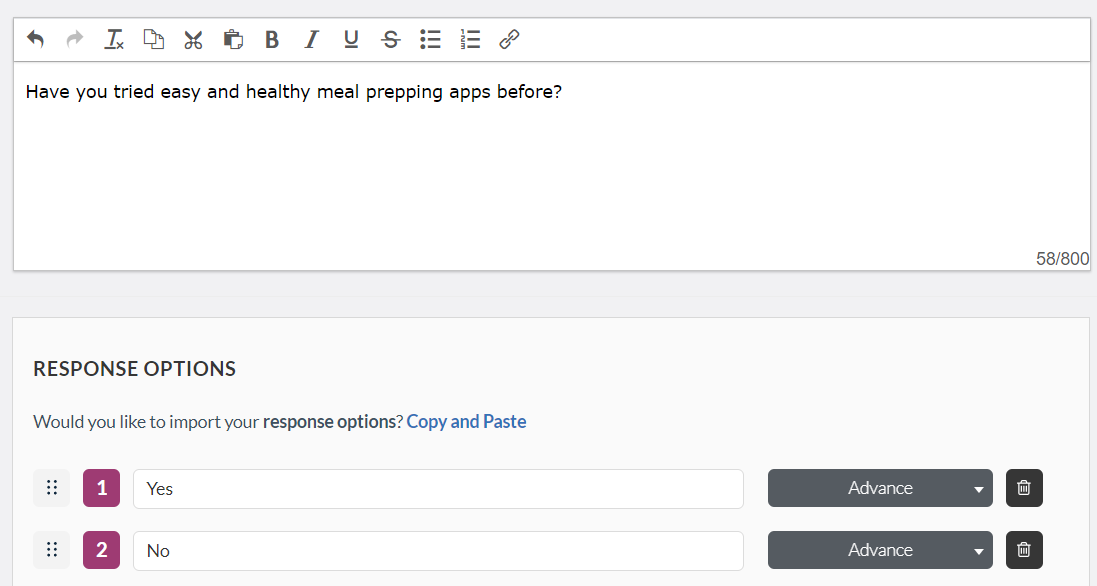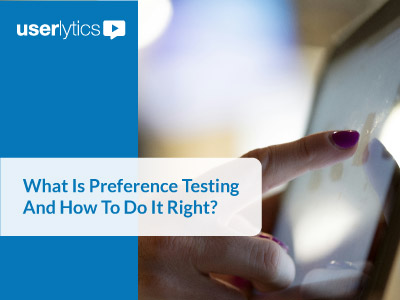The success of your UX research depends on the relevance of your testing participants.
Think of it like casting actors for a blockbuster movie, where everyone must work together to create something great.
In UX research, it’s crucial to recruit participants who reflect your target audience to gain useful insights. To recruit participants for a UX study, use strategic methods to engage the right candidates.
This article will teach you 9 essential tips on how to recruit participants for a UX study.
Define Your User Testing Study
Defining your UX study sets the stage. Before taking any action, outline the study’s scope and goals.
This first step involves clarifying the questions your study aims to answer, giving clear direction for your recruitment efforts.

Suppose our UX research aims to evaluate the usability of a new meal-planning app for young professionals with busy lives who want to maintain a healthy diet.
The app offers quick, nutritious meal solutions that require minimal effort.
The study will focus on the app’s ease of use, the appeal of its meal suggestions, and how well it fits into a hectic lifestyle.
It will also explore what motivates users to keep using the app and follow its meal plans.
Create a Participant Persona
With the groundwork of your user research study laid out, the exciting phase of creating a participant persona comes into play
To recruit participants for a UX study, this persona should include not just demographic details like age and income but also psychographics such as behaviors, motivations, and lifestyle choices. This provides a complete view of your ideal participant, ensuring you recruit participants for a UX study who fit your needs.

Let’s expand on the healthy, quick meal solutions example, and consider the case of Emily, the aspiring healthy eater.
Background:
- Name: Emily Nguyen
- Age: 29
- Occupation: Marketing Specialist at a tech startup
- Education: Bachelor’s degree in Communications
- Location: Urban, living in a city apartment in San Francisco, CA
- Family Situation: Single, lives with a roommate
Demographics:
- Gender: Female
- Income: $65,000 per year
- Ethnicity: Vietnamese-American
Psychographics:
- Lifestyle: Busy and active, Emily juggles her demanding job with a love for social activities, including dining out with friends, attending fitness classes, and participating in local community events.
- Behaviors: Health-conscious but struggles to maintain a consistent healthy eating pattern due to her hectic lifestyle. Prefers quick and easy meal solutions that don’t compromise on nutritional value. Engages with health and wellness content on social media and follows several fitness influencers for inspiration.
- Needs and Desires: Emily is seeking ways to incorporate healthier eating habits into her fast-paced life. She is particularly interested in learning how to prepare quick, nutritious meals and values convenience and accessibility in food choices.
- Pain Points: Lack of time to prepare meals and limited knowledge of nutritious recipes. Feels overwhelmed by the abundance of health information online and seeks reliable, straightforward guidance.
- Goals and Aspirations: Aspires to achieve a balanced lifestyle where she can excel in her career while also taking care of her health and well-being. Emily is motivated to learn more about nutrition and healthy cooking to empower her dietary choices.
Media Consumption:
- Preferred Channels: Instagram, Pinterest, TikTok, and health-focused blogs
- Content Preferences: Enjoys visually appealing, easy-to-follow content such as quick recipe videos, infographics on nutrition, and relatable posts from wellness influencers.
When you recruit participants for a UX study, especially for a meal-planning app, it is crucial to consider individuals like Emily who reflect your target audience.
By recruiting participants for a UX study who share Emily’s characteristics, you can ensure your app meets the needs and preferences of your intended users.
Explore and Understand UX Recruitment Methods
Having created your user testing participant persona, it’s time to explore the avenues available to recruit participants for a UX study.
Whether it’s user panels, social media platforms, or specialized recruitment services, each channel offers unique advantages and challenges. It’s important to select a method that aligns with your UX study’s objectives and resonates with your target persona.
When you recruit participants for a UX study, choose channels that best reach individuals like your ideal participant.

Given Emily’s profile, recruiting her for a study on user experiences with a new healthy meal planning app would involve reaching out through platforms where she is active, such as Instagram.
Target the Right Audience With Incentives and Compensation
With your recruitment channels in place, the focus shifts to reaching and enticing your target audience. This is where the art of persuasion plays a crucial role.
To recruit participants for a UX study, understand that quality participation often comes with a price. Offering attractive incentives and compensation is not just an act of goodwill but a strategic move to ensure participant engagement.
From monetary rewards to exclusive access to your product, the incentives should be compelling enough to draw the right testers when you recruit participants for a UX study.

In Emily’s case, the UX recruitment message could highlight how participation in the user research study offers an exclusive opportunity to influence the development of an innovative app designed to solve her meal prep challenges.
To recruit participants for a UX study, offering incentives like free access to the app post-launch or a collection of quick healthy recipes tailored to her lifestyle could further entice her to participate.
These incentives will make it more appealing to recruit participants for a UX study who match Emily’s profile.
Determine If Your Study Will Be Moderated or Unmoderated
Moderated studies are like live auditions where the UX researcher interacts with participants in real-time. This setup allows for immediate follow-up questions and deeper exploration of user behaviors.
It’s particularly useful for complex UX studies where understanding the context of user actions or reactions is crucial. The UX researcher can adapt the discussion based on the participant’s responses, probe deeper into interesting findings, and clarify any ambiguous feedback on the spot. This makes it essential to recruit participants for a UX study who can provide valuable insights during live interactions.
Unmoderated Studies, on the other hand, offer participants the flexibility to complete usability and user experience tasks at their convenience.
This method is often more scalable and cost-effective, allowing UX researchers to gather data from a wider geographic distribution without the logistical constraints of scheduling and real-time interaction.
Unmoderated UX studies are ideal for straightforward tasks where the research objectives are clear-cut and don’t require real-time clarification.

In Emily’s case, the choice between moderated and unmoderated user experience testing methods would depend on the depth of insight required.
An unmoderated UX study might ask Emily to use the meal planning app either in a single session or over the course of a week (a Diary Study), recording her interactions and any challenges she encounters.
This approach would allow Emily to integrate the app into her busy lifestyle at her convenience, providing genuine user experience feedback on how well the app fits her daily routine and meets her needs for quick, healthy meal solutions.
In contrast, a moderated UX study might involve a scheduled one-on-one session, where she navigates the app in real-time under the guidance of a UX researcher.
This setting would enable the UX researcher to observe Emily’s immediate reactions, ask why she made certain choices, and delve deeper into her user experience.
For example, if Emily hesitates over a particular feature or expresses delight at a specific recipe suggestion, the UX researcher can probe further to understand the underlying reasons.
To recruit participants for a UX study that includes moderated sessions, it’s crucial to find individuals like Emily who can provide detailed insights during live interactions.
Both approaches offer valuable perspectives on Emily’s interaction with the app, but the choice between moderated and unmoderated UX studies depends on the specific user research goals, the complexity of the app’s features, and the depth of understanding required to inform UX design improvements.
Reach Out To Potential Participants
With a clear strategy in place, recruitment outreach becomes the linchpin of your efforts. This is your chance to craft compelling messages that resonate with potential participants.
To recruit participants for a UX study, your outreach should not only inform but also excite and motivate, making potential UX research participants feel like they are part of something great.
Crafting messages that highlight the importance of their role and the impact they can have will help recruit participants for a UX study effectively.

For someone like Emily, who leads a busy lifestyle yet is keen on having healthy eating habits, the outreach communication needs to be concise, engaging, and directly aligned with her goals. To recruit participants for a UX study like Emily, a targeted message via Instagram, featuring visually appealing content related to healthy eating, could grab her attention. The message could highlight the opportunity to contribute to an app that promises to simplify her meal prep process, offering solutions for her hectic lifestyle. Personalizing this message can make the outreach more compelling and help recruit participants for a UX study like her effectively.
Screen Participants Effectively
As responses to your outreach begin to flood in, the critical task of screening participants takes center stage.
To recruit participants for a UX study, only the most fitting candidates should be selected. A rigorous screening process, equipped with well-thought-out criteria and questions, is essential to sift through the applicants. This ensures that only those who truly embody your target persona make it into the UX study.
By carefully screening to recruit participants for a UX study, you can maintain the quality and relevance of your research insights.

For Emily, the screening might include questions about her daily routine, dietary preferences, previous experiences with meal planning apps, and specific challenges she faces in maintaining a healthy diet. This targeted screening helps confirm that Emily’s profile matches the user experience study’s target persona, ensuring that her feedback and insights will be highly relevant and valuable.
Deal with No-Shows By Over-Recruiting
Despite thorough participant recruitment and screening, no-shows can disrupt the research schedule. To recruit participants for a UX study, especially someone like Emily who has a packed calendar, the chances of last-minute changes are high. To mitigate this, over-recruitment is a strategy to ensure enough user research participants are lined up to fill any gaps.
Moreover, offering flexible scheduling options and sending reminders can significantly reduce no-show rates. In the event of a no-show, having a quick rescheduling process can help retain interested participants like Emily, ensuring their valuable UX insights aren’t lost due to scheduling conflicts. By taking these steps to recruit participants for a UX study, you can maintain a smooth and effective research process.
Analyze Your Recruitment Strategy’s Success
After completing the study, analyzing the recruitment process’s success is vital. Metrics such as the completion rate, the relevance of the feedback to the user research objectives, and participant satisfaction with the UX study process are key indicators.
Reviewing Emily’s journey from recruitment through participation can offer insights into what worked well and areas for improvement. For instance, if Emily found the scheduling flexibility and personalized communication particularly appealing, these aspects can be highlighted as best practices for future UX research studies. Conversely, any challenges she faced, like unclear instructions or technical issues with the UX study platform, can be addressed to enhance the experience for similar participants.
In conclusion, the journey to recruit participants for a UX study requires precision, understanding, and some creativity to find the perfect match. From defining the UX research study and creating detailed personas like Emily’s to choosing the right recruitment methods and managing participant engagement effectively, each step is crucial to the success of your UX research.
By tailoring your approach to meet the unique needs and preferences of your target participants, you can ensure a rich and insightful data collection process that truly enhances the value of your UX research.
If you’re looking to streamline your participant recruitment process, Userlytics has one of the largest panels, and the largest international user testing panel with over 2 million participants registered worldwide.
Leveraging our expertise and extensive network, we ensure that you connect with participants who not only match your specific criteria but are also engaged and motivated to contribute meaningfully to your study.
Whether you’re conducting moderated or unmoderated UX studies, dealing with niche markets or broad audiences, our UX panel as well as our user experience testing platform will provide you with the high-quality UX research insights you need to make informed product decisions. Consider reaching out to us to find out more.
About the Author: Mehdi El Taghdouini

Mehdi is the Head of Content and Communications at Userlytics. He is skilled at writing clear and engaging content on several topics, especially technology and SaaS products. Before joining Userlytics, Mehdi led the content marketing team of the largest Google Cloud and Google Workspace reseller in the Benelux market. He brings six years of experience in managing content for both startups and large companies. Mehdi holds a Bachelor\'s degree in E-Business and enjoys photography in his spare time. His photography projects have been exhibited in Brussels, Hong Kong, and Barcelona, where he now lives.
Connect with Mehdi





